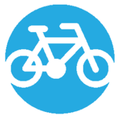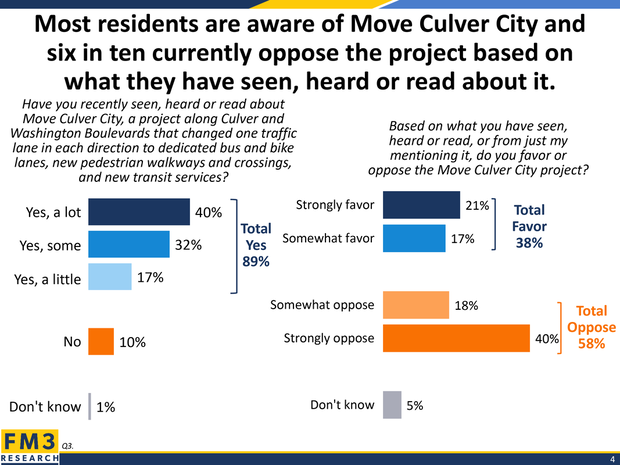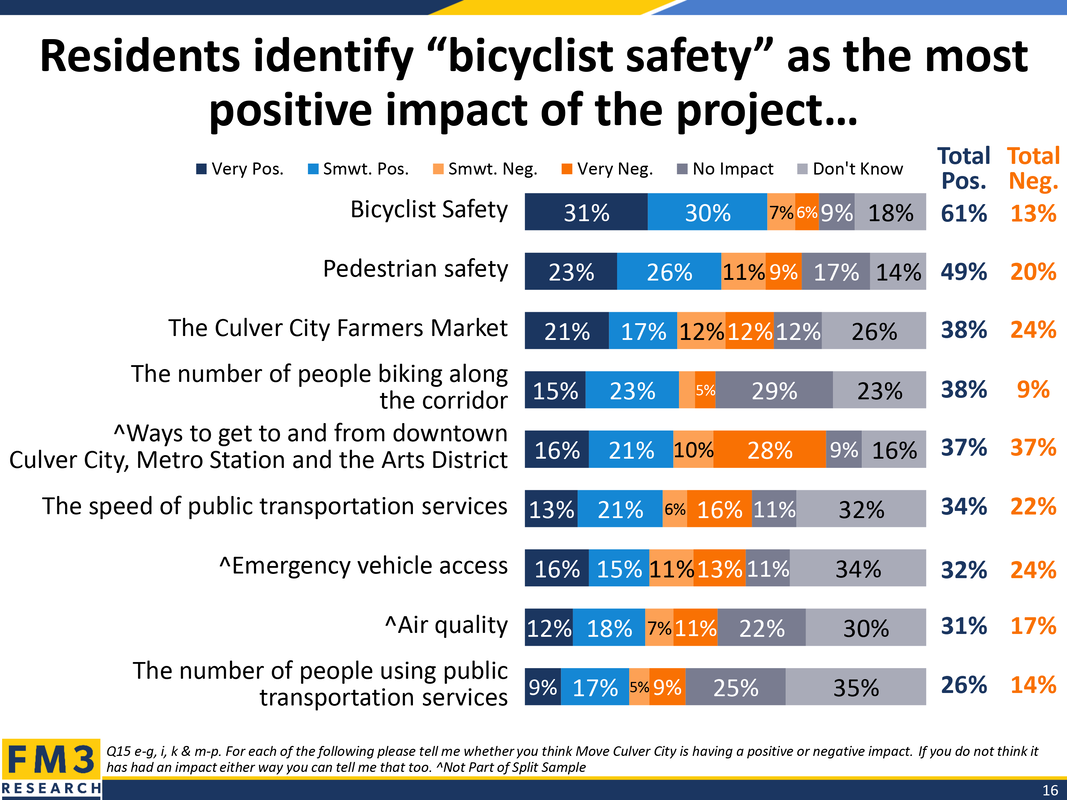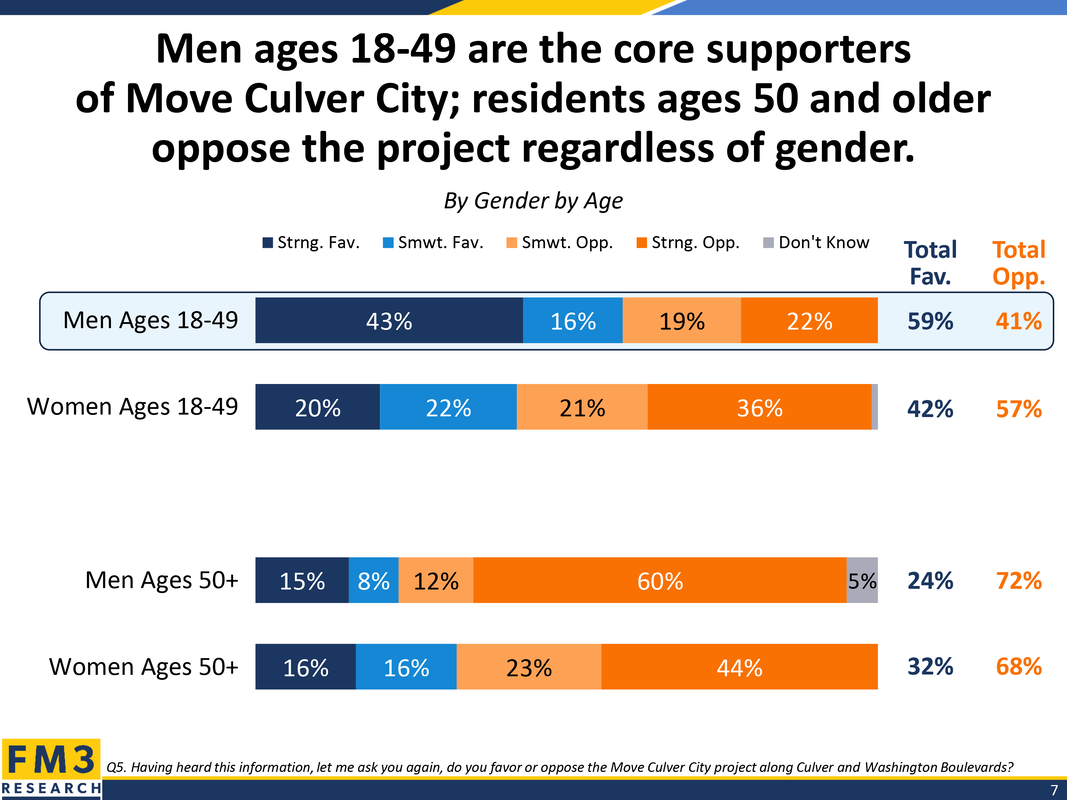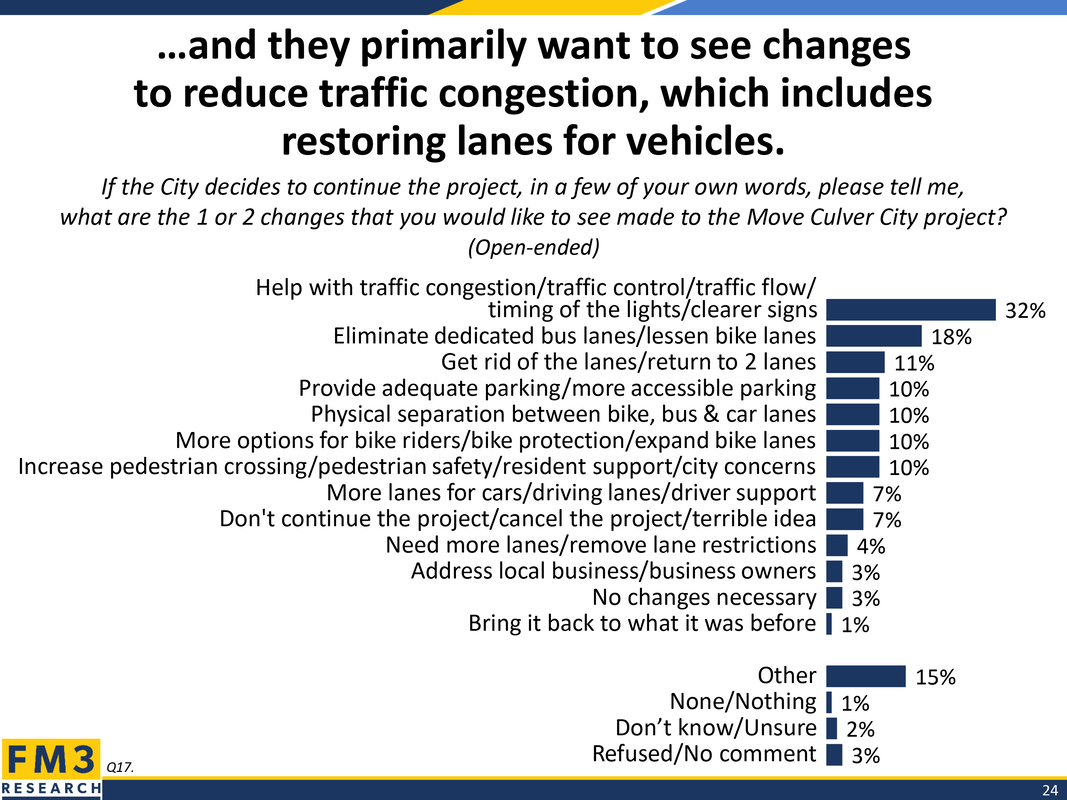Background
In 2021, the Culver City City Council launched MOVE Culver City – a pilot program to study and improve travel for bus riders, cyclists, emergency vehicles and pedestrians, chiefly in the Culver City downtown and Arts District.
The program is what is called a "quick build" - that is, according to the city's website, Move Culver City "was constructed quickly and at low cost, using temporary materials to allow for design flexibility in response to community feedback." Some of the changes included removing two car lanes going west on Culver Blvd, and one car lane going east, and installing dedicated bus and bikes lanes. In short, Move Culver City is the study.
Studies and Surveys Show No Increased Bike or Bus Use, Majority of Culver Residents Want Changes to the Project
Since its implementation the city completed two project studies: a Mid-pilot Report, released October, 2022, and a Public Opinion Survey, presented at the March 27, 2023 City Council meeting.
Results
Now What?
Taking the pilot report, other data, and the public opinion survey into account, the City staff presented their ideas regarding the future of Move Culver City at the April 24th, 2023 City Council Meeting. The Council Majority, (Eriksson, Vera, and O'Brien), voted to return a car lane of traffic, combine the bus lane and bike lanes into a "Shared Bus Bike Lane/SBBL," and to extend the SBBL on Washington Blvd. to the Los Angeles border.
The project is on hold due to the lawsuit brought by an anonymous group called 'Friends of Move Culver City" (the name has changed several times). You can see their GoFundMe page here.
There are strong opinions about Move Culver City from many perspectives. What is clear, is that the majority want people- regardless of whether they choose to drive, walk, or cycle through Culver City - to be safe.
Please read below to see our analysis of the main reports in more detail.
In 2021, the Culver City City Council launched MOVE Culver City – a pilot program to study and improve travel for bus riders, cyclists, emergency vehicles and pedestrians, chiefly in the Culver City downtown and Arts District.
The program is what is called a "quick build" - that is, according to the city's website, Move Culver City "was constructed quickly and at low cost, using temporary materials to allow for design flexibility in response to community feedback." Some of the changes included removing two car lanes going west on Culver Blvd, and one car lane going east, and installing dedicated bus and bikes lanes. In short, Move Culver City is the study.
Studies and Surveys Show No Increased Bike or Bus Use, Majority of Culver Residents Want Changes to the Project
Since its implementation the city completed two project studies: a Mid-pilot Report, released October, 2022, and a Public Opinion Survey, presented at the March 27, 2023 City Council meeting.
Results
- Mid-Pilot Report: Despite the city's best attempt to increase bus ridership, cut auto traffic time, and improve pedestrian and cycling safety, the results of the mid-pilot report showed that:
- bus ridership is below pre-pandemic levels
- cycling ridership showed no increase during the week
- downtown businesses report that, adjusted for inflation, sales tax did not increase exponentially
- Public Opinion Survey: The survey, conducted by an independent firm, showed that:
- 60% of the residents in Culver City oppose Move Culver City
- 85% of those surveyed want MOVE either revised per residents' and businesses' concerns or removed entirely.
- majority want downtown and the Arts District to be safe for cyclists and pedestrians
- the majority want the auto lanes to be restored.
- Independent Audit: There is some chatter online that the Independent audit conducted by Kimley-Horn & Associates, Inc. (submitted to the City November, 2022) proves that MOVE Culver City was a success. As a point of information, the audit does not state, nor could it, whether the MOVE pilot project is a success or failure, nor does it offer any causal explanation for why transit numbers change over time. Moreover when adopted, the project had no specified criteria for measuring success. In other words, there is a difference between data collection and data analysis. You can view the audit report here.
Now What?
Taking the pilot report, other data, and the public opinion survey into account, the City staff presented their ideas regarding the future of Move Culver City at the April 24th, 2023 City Council Meeting. The Council Majority, (Eriksson, Vera, and O'Brien), voted to return a car lane of traffic, combine the bus lane and bike lanes into a "Shared Bus Bike Lane/SBBL," and to extend the SBBL on Washington Blvd. to the Los Angeles border.
The project is on hold due to the lawsuit brought by an anonymous group called 'Friends of Move Culver City" (the name has changed several times). You can see their GoFundMe page here.
There are strong opinions about Move Culver City from many perspectives. What is clear, is that the majority want people- regardless of whether they choose to drive, walk, or cycle through Culver City - to be safe.
Please read below to see our analysis of the main reports in more detail.
Mid-Pilot Report
Despite the city's best attempt to increase bus ridership, cut auto traffic time, and improve pedestrian and cycling safety, the results of the mid-pilot report showed that bus ridership is below pre-pandemic levels and cycling ridership showed no increase during the week. 2021 was still in the height of the pandemic. The city's report cites pedestrian traffic up 18% in 2022 compared to 2021 for example. there is no data for pre-pandemic. Furthermore, downtown businesses report that, adjusted for inflation, sales tax did not increase, indicating that sales did not go up.
The Details:
The city released this mid-pilot report. It must be noted that the report is mostly comparing numbers from during the height of the pandemic to numbers after the pandemic. There is little data to compare the effects of Move Culver City from time prior to the Pandemic.
The Details:
The city released this mid-pilot report. It must be noted that the report is mostly comparing numbers from during the height of the pandemic to numbers after the pandemic. There is little data to compare the effects of Move Culver City from time prior to the Pandemic.
|
Bus Ridership:
Graphic from the city's mid-pilot report:
In looking at data from the American Public Transportation Association, you can see that Culver City bus ridership is still below pre-pandemic. You can also see that while the city's rebound looks good, it's on par with other cities that presumably don't have mobility projects like MOVE.
|
|
Bicycle Ridership:
Image from the city's one page flyer:
When comparing weekdays to weekdays (November 2019 and November 2022) , cycling activity/bicycle commuting did not increase during Move Culver City in 2022 from pre-pandemic 2019. See below:
Here is the data comparing November to November from Move Culver City's November report:
|
|
Sales Tax
Finally, there has been some discussion about business tax revenue. Based on data, here is a graphic that shows that adjusted for inflation, revenue in 2022 did not grow exponentially from when MOVE was introduced in 2021. In other words, the chart shows that sales tax data fell in the quarter when Move was introduced and is still at or below the summer of 2021. The red line shows revenue adjusted for inflation.
At the time of this write-up, we are diving into historical events that happened in 2021 which may have contributed to the spike in sales tax revenue in 3Q, including the opening of new businesses in the Culver Steps. Please check back for updates. |
Sources:
Move Culver City Public Opinion Survey
Public Opinion Survey: The survey, conducted by an independent firm, showed that 60% of the residents in Culver City oppose Move Culver City. Of those residents, 48% say that they would support it with changes. Primarily, while they want downtown and the Arts District to be safe for cyclists and pedestrians, the majority want the auto lanes to be restored.
- MOVE CULVER CITY
- The Move poll results were presented to the council and are now available on the web.
- What the survey showed:
- 6 in 10 people oppose or strongly oppose the Move project and say that it negatively affects their lives.
- The initial reaction was 58% disapprove and 38% approve.
- After additional questions, the number of people in opposition grew to 60%
- The largest point of opposition is the reduction to a single lane of vehicle traffic
- 413 people in survey, chosen to represent the ethnic and economic representation of people in Culver City
- Survey was provided in both English and Spanish.
- The only group who overwhelmingly liked the project were white men aged 18-49
- Overall, women oppose the project 18-49: 57% opposition, 50+: 68% opposition
- Latino and Asian/Pacific Islanders had the most opposition to the project
- A majority opposed the removal of car lanes into a single lane in both directions.
- Residents say the "bicyclist safety" is a good thing about the project
- 85% of those surveyed want MOVE either revised per residents' and businesses' concerns or removed entirely.
- 38% of the people surveyed want to get rid of the project entirely
- Only 13% want to keep the project as-is
CLICK HERE TO SEE THE SURVEY RESULTS DOCUMENT




